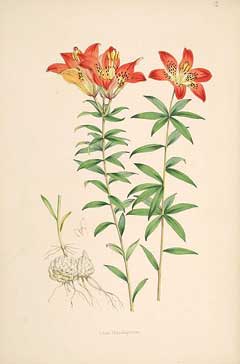
Wood Lily
Latin Name: Lilium philadelphicum
USDA Hardiness: 4-8
Native Range: NORTHERN AMERICA: Canada, Québec, Ontario, Saskatchewan, Alberta, Manitoba, British Columbia, United States, Connecticut, Indiana, Maine, Massachusetts, Michigan, New Hampshire, New Jersey, New York, Ohio, Pennsylvania, Rhode Island, Vermont, West Virginia, Illinois, Iowa, Minnesota, Missouri, Nebraska, North Dakota, South Dakota, Wisconsin, Colorado, Montana, Wyoming, Delaware, Georgia, Kentucky, Maryland, North Carolina, South Carolina, Tennessee, Virginia, District of Columbia, New Mexico, Texas,
Edibility Rating: 3 / 5
Medicinal Rating: 1 / 5
Region:
Family:
Plant Type:
Medicinal Uses
Edible Uses
Edible Parts: Root | Edible Uses: Bulb - cooked[257]. Used as a potato substitute[46, 61, 105, 161]. Starchy and slightly sweet[85]. Rather small, it is up to 25mm in diameter[235].
Cultivation
Requires a well-drained humus-rich soil and a cool moist root run[1, 42, 143]. Likes a warm position with moisture in summer[47]. Stoloniferous[200]. Plants are rather difficult to establish[143]. Early to mid autumn is the best time to plant out the bulbs in cool temperate areas, in warmer areas they can be planted out as late as late autumn[200]. A very ornamental plant[1], it requires protection from rain in winter[143]. The plant should be protected against rabbits and slugs in early spring. If the shoot tip is eaten out the bulb will not grow in that year and will lose vigour[200]. The plant is heat tolerant in zones 8 through 5. (Plant Hardiness Zones show how well plants withstand cold winter temperatures. Plant Heat Zones show when plants would start suffering from the heat. The Plant Heat Zone map is based on the number of "heat days" experienced in a given area where the temperature climbs to over 86 degrees F (30°C). At this temperature, many plants begin to suffer physiological damage. Heat Zones range from 1 (no heat days) to 12 (210 or more heat days). For example Heat Zone. 11-1 indicates that the plant is heat tolerant in zones 11 through 1.) For polyculture design as well as the above-ground architecture (form - tree, shrub etc. and size shown above) information on the habit and root pattern is also useful and given here if available. The plant growth habit is a clumper with limited spread [1-2]. The root pattern is a bulb. The root pattern is stoloniferous rooting from creeping stems above the ground [1-2].
Known Hazards
None known
Habitats
Heavy, often somewhat alkaline, meadows to montane forest[60]. Usually found in drier woodlands on acid sandy loams[43, 47].
